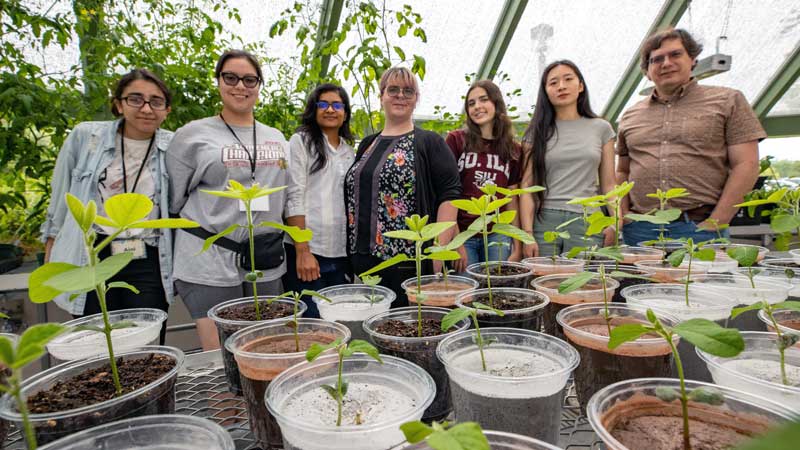
(Above) Students tend to plants growing in simulated moon regolith at Southern Illinois University Carbondale. (Below, from left): High school and SIU students working on the project include Aini Ahmed, Illinois Mathematics and Science Academy; Sarah Almeida, IMSA; Chetan Singh, graduate student in microbiology; Hannah Phillips, senior in microbiology; Danielle Snyder, freshman in microbiology; Alyssa Zhan, senior in plant science and Scott Hamilton-Brehm, associate professor of microbiology. The IMSA students volunteered to work on the project while visiting SIU for a summer program put on by the STEM Education Research Center. (Photos by Russell Bailey)
September 17, 2024
Student research team at SIU hopes to discuss research on space-age crops with professionals
CARBONDALE, Ill. – Students led by a Southern Illinois University Carbondale researcher may have the rare opportunity to present their research on using microalgae to grow crops in regolith, like the surface of the moon, to scientists and other professionals.
Five abstracts from SIU’s AlgaeUnlocked team, led by Scott D. Hamilton-Brehm, associate professor in the School of Biological Sciences, have been accepted for presentation at a conference highlighting the important role algae plays in capturing and utilizing carbon dioxide. The team, one of just 15 nationwide finalists for the U.S. Department of Energy’s AlgaePrize, is working on a project that could be used to grow crops in off-Earth environments such as its moon and Mars.
“It is extraordinary for undergraduates and high school students to have their work accepted for presentation at an international science conference and it showcases the research education they are getting here in Carbondale,” Hamilton-Brehm said. “It will give them a chance to learn firsthand what it’s like to present preliminary research — something they will do regularly as career scientists.”
The team is trying to raise $10,000 by April 10 to attend the Algae Biomass Summit, Oct. 20-22 in Houston, and to travel to the National Renewable Energy Laboratory for the final 2023-25 AlgaePrize competition, April 11-13 in Golden, Colorado. That event will culminate in the AlgaePrize grand champion being announced.
Earlier this year, the SIU team received a $10,000 grant to find ways to use microalgae combined with another patented technology created by an SIU spinoff company to produce biostimulants and biofuels. AlgaeUnlocked, composed of students from SIU and Carbondale Community High School, competed against almost 50 other teams nationwide for the grant.
The AlgaeUnlocked team includes SIU students Hannah Phillips, Alex Bechtel, Chetan Singh, Danielle Snyder and Alyssa Zhan.
Contributions to the team will pay for travel expenses, registration, hotels, car rental, gas and research supplies, such as plant soil, pots for biostimulant studies, soil analysis and aquariums to grow algae. The team also has been making videos illustrating its progress toward the research goals.
The Algae Biomass Summit is a large gathering of algae and seaweed professionals, including commercial leaders, entrepreneurs, scientists, policymakers, investors and young innovators from around the world. Speakers and attendees will include national and international technologists, senior executives of commercial algae companies, product developers, marketers, academics researching algae science and cultivation methods, as well as federal policy makers tasked with advancing technology.
“The AlgaePrize goal is to find better ways to process and use microalgae,” Hamilton-Brehm said. “SIU is currently the only place where the novel technology oxidative hydrothermal dissolution is located. Preliminary research from a SIU REACH award, allowed the students to connect the dots and proposed a way to use OHD processed microalgae to feed and support crops in future space exploration colonies.”
OHD is an environmentally friendly technology that uses heat, pressure, oxygen and water to break down complex organic materials into simple, water-soluble products. The technology was pioneered by Ken Anderson, director of SIU’s Advanced Energy Research Center.
Hamilton-Brehm said the team is experimenting with using the OHD-processed microalgae to grow corn, cannabis and soybeans. With soybeans, the team has planted them in simulated lunar and Martian regolith. The team is experimenting with growing the plants outdoors at the SIU Farms research fields, the campus research greenhouses and in Hamilton-Brehm’s laboratory.
So far, the experiment has been a success, with cannabis and soybeans growing up to 100% more than their control counterparts.

